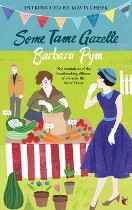 Barbara Pym •
Barbara Pym •
Some Tame Gazelle •
Barbara Pym’s novels are peopled by deceptively innocent-looking characters—clergymen, spinsters, anthropologists. But Pym is adept at lifting the lid of convention to expose the absurdities beneath.
The anthropologists, though well versed in the ritual devouring of human flesh, are out of their depth at Oxford dinner parties. A widower places the wrong flowers on the grave of his wife, having confused her preferences with those of a mistress. A vicar is suspected of idolatry for keeping soap animals in the washroom.
In Some Tame Gazelle, sisters Harriet and Belinda Bede find their settled existence threatened by not one but two proposals of marriage. Harriet is courted by a librarian named Nat Mold, whom she waggishly teases about reading Stitchcraft. Belinda suffers the attentions of a visiting bishop who reminds her of two animals at once: “Fish and sheep. Was that possible?”
Then there’s the discussion about where to hang a calendar from the new curate, should he choose to send one. Belinda suggests “some convenient spot so that you can read it at the beginning of the day.” Harriet, shocked, replies that they certainly won’t put it there. “It shall go in the dining-room.”
Pym’s literary executor, Hazel Holt, once observed, “Very few people, I imagine, read Barbara for her plots.” The plots may be inconsequential, but the characters—like the writing itself—are indelible.







What a great nugget of a review. Fun. Laughed out loud. Great way to start my day!